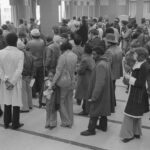A review of State of the Nation: An Agenda for Change. Edited by Jennifer Buckingham.
Centre for Independent Studies, 2004.
This is the fourth edition of a helpful reference work that comes from the Centre for Independent Studies in Sydney. The 162-page paperback covers most of the important Australian social statistics. Chapters deals with population and immigration; family, marriage and fertility; civil society; school education; higher education; health; welfare; poverty. Tax and income distribution; labour market; economic performance; economic freedom; and aid and development.
While much of this information is found elsewhere, as in Australian Bureau of Statistics publications, it is very helpful to have all the information under one roof. Moreover, this volume does not simply present statistics and facts and figures. It also provides some commentary on the data, and offers policy proposals for the way ahead.
The marriage and family figures make for interesting reading. They are both revealing and alarming. For example, since the early 60s, fertility rates have been in steep decline. The current birth rate of 1.7 children per woman is well below the replacement level of 2.1, and shows no sign of levelling off, let alone increasing.
Related closely to the declining fertility rate is the declining marriage rate. While a number of factors may explain this, and one cannot make a tight one-to-one correlation between the two, it remains that “the marriage rate is falling in lock-step with the birth rate”. Indeed, recent research by Bob Birrell of Monash University shows a very close connection between falling partnering rates, falling marriage rates, and falling fertility rates.
In a similar regard, there is “a close statistical connection between an increasing divorce rate and a decreasing fertility rate” during the past four decades. Then there is the related and also problematic trend in the rise in the age of marriage, with 29 years the median age for men and 27 for women in 2002. This compares with 23 for men and 21 for women in 1970. Putting off marriage and childbearing till later in life will also result in fewer children being born.
Then there is the rise in cohabitation and de facto relationships, with 12 per cent of all couple families now made up of de facto couples. And as research has consistently shown, those who cohabit before marriage experience higher divorce rates. For example, after 20 years of marriage, 56 per cent of cohabiting couples will divorce, compared to just 27 per cent of non-cohabiting couples.
Also, around 30 per cent of dependent children are separated from one of their natural parents. In about 90 per cent of the cases, the child lives with the mother.
In 2002 there were 78,438 ex-nuptial births, or almost a third of all births.
The chapter on family makes it clear that the Australian family has grown weaker and is facing some stiff challenges. The authors recommend that two major approaches should be taken to rescue the faltering family. One is to reform the family tax system. The other is to reform divorce law so that one party may not unilaterally pull out of a marriage.
Many other social indicators can be highlighted. Consider crime in Australia. While there was a decline in serious crime between 2000 and 2002, the trend over the last 40 years has been a steady increase, in fact a seven-fold increase.
On the education front, several trends can be mentioned. A century ago around 20 per cent of all students were in non-government schools. Today that figure has risen to almost a third. The bulk of this increase has been in new independent schools, particularly low fee, non-denominational Christian schools.
Also, boys continue to perform less well in school than girls, especially in government schools. Boys tend to have lesser literary levels in primary school, and tend to do worse in most secondary subjects, with the gap widening as they progress through school.
This may in part be related to the fact that the number of male teachers continues to decline, again especially in government schools. In 1992 men number one in four in government primary schools. Today they are one in five.
On another front, it appears that mandatory detention of illegal immigrants has had a positive effect, with people smuggling to Australia down substantially, and the number of asylum seekers arriving in Australia effectively halved between 2001 and 2002.
In the meantime government red tape continues to expand exponentially. Legislation on both state and federal levels continues to increase. For example, in 1901 there was an average of around 25 Commonwealth Acts passed that year, while in 2003 this had risen to 150.
All in all this book gives us a mixed report on the wellbeing of the nation. By some indicators we are doing pretty well. Australians are healthier and wealthier than ever before. But by a number of other indicators, we are going backwards. This volume provides a number of snapshots of life in Australia. Good and bad information emerges. But it is a very helpful resource which one hopes will go through many future editions.
[829 words]



















